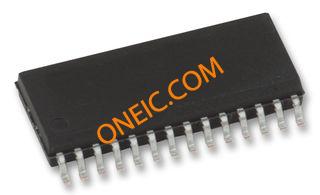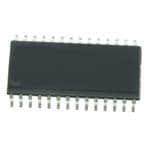MC9S08SH32CWL
8-bit microcontrollers with 32KB Flash memory in 28-pin SOIC format
Manufacturer: ['freescale', 'nxp']
series introduction
# Introduction to the MC9S08SH32CWL Product Series
## 1. Overview
The MC9S08SH32CWL is a member of the highly versatile and reliable 8 - bit microcontroller product series developed by Freescale (now NXP Semiconductors). This series is designed to meet a wide range of embedded applications, offering a balance of performance, power efficiency, and cost - effectiveness.
## 2. Core and Architecture
### 2.1 CPU Core
- The MC9S08SH32CWL is based on the HCS08 CPU core. This 8 - bit core provides a simple yet powerful instruction set architecture that is easy to program and understand. It offers a good combination of processing speed and code density, making it suitable for applications where memory usage and processing efficiency are crucial.
- The core has a fast interrupt response time, which is essential for real - time applications. It can quickly handle external events such as sensor inputs or communication requests, ensuring that the system can respond promptly to changing conditions.
### 2.2 Memory Architecture
- **Flash Memory**: It comes with 32 KB of in - system programmable flash memory. This non - volatile memory allows for easy code updates and storage of application programs. The flash memory has a high endurance, which means it can withstand a large number of erase and program cycles, making it suitable for long - term use in various applications.
- **Random - Access Memory (RAM)**: The microcontroller is equipped with 2 KB of RAM. This memory is used for storing temporary data during program execution, such as variables, buffers, and stack space. The sufficient amount of RAM enables the execution of relatively complex algorithms and data - handling tasks.
## 3. Peripherals
### 3.1 Serial Communication Interfaces
- **Universal Asynchronous Receiver/Transmitter (UART)**: The MC9S08SH32CWL features a UART interface, which is commonly used for serial communication with other devices such as sensors, displays, or other microcontrollers. It supports a wide range of baud rates, allowing for flexible communication speeds. The UART can operate in both full - duplex and half - duplex modes, providing versatility in different communication scenarios.
- **Serial Peripheral Interface (SPI)**: The SPI interface is available for high - speed serial communication with external devices. It allows for fast data transfer between the microcontroller and SPI - compatible devices such as EEPROMs, ADCs, or DACs. The SPI interface supports multiple master and slave configurations, enabling the connection of multiple devices in a daisy - chain or parallel arrangement.
- **Inter - Integrated Circuit (I2C)**: The I2C interface provides a simple and efficient way to communicate with other I2C - compliant devices. It uses a two - wire bus (SDA and SCL) for data transfer and is widely used for connecting sensors, real - time clocks, and other low - speed peripheral devices. The I2C interface supports multiple slave addresses, allowing for the connection of multiple devices on the same bus.
### 3.2 Timers and Counters
- **Timer/PWM Modules**: The microcontroller includes timer and pulse - width modulation (PWM) modules. These modules can be used for a variety of applications, such as generating precise timing signals, controlling the speed of motors, or dimming LEDs. The PWM outputs can be configured to generate different duty cycles, which is useful for controlling the power delivered to external devices.
- **Real - Time Counter (RTC)**: The RTC provides a simple and accurate way to keep track of time. It can be used for applications that require time - stamping, scheduling events, or implementing power - management strategies based on time. The RTC can operate independently of the main
Images for reference

28-SOIC

Image Preview

Image Preview